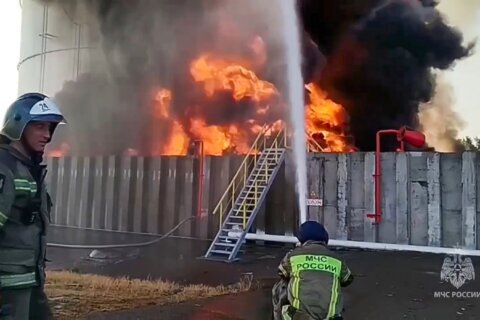NEW YORK (AP) — Gas prices are once again on the decline across the U.S., bringing some relief to drivers now paying a little less to fill up their tanks.
The national average for gas prices on Monday stood around $3.44, according to AAA. That’s down about 9 cents from a week ago — marking the largest one-week drop recorded by the motor club so far in 2024. Monday’s average was also more than 19 cents less than it was a month ago and over 14 cents below the level seen this time last year.
Why the recent fall in prices at the pump? Industry analysts point to a blend of lackluster demand and strong supply — as well as relatively mild oil prices worldwide.
Here’s a rundown of what you need to know.
Today’s falling gas prices, explained.
There are a few factors contributing to today’s falling gas prices. For starters, fewer people may be hitting the road.
“Demand is just kind of shallow,” AAA spokesperson Andrew Gross said, pointing to trends seen last year and potential lingering impacts of the COVID-19 pandemic. “Traditionally — pre-pandemic — after Memorial Day, demand would start to pick up in the summertime. And we just don’t see it anymore.”
Last week, data from the Energy Information Administration showed that U.S. gasoline demand slipped to about 8.94 million barrels a day. That might still sound like a lot — but before the pandemic, consumption could reach closer to the 10 million barrel-a-day range at this time of year, Gross noted.
Beyond pandemic-specific impacts, experts note that high gas prices seen following Russia’s invasion of Ukraine in 2022 and persistent inflation may have led many Americans to modify their driving habits. Other contributing factors could be the increased number of fuel-efficient cars, as well as electric vehicles, on the road today, Gross said.
Some of this is still seasonal. Patrick De Haan, head of petroleum analysis at GasBuddy, noted that gas prices typically ease in early summer because of refinery capacity. At this time of year, he said, many factors boosting prices in late winter and early spring — particularly refinery maintenance — are no longer present.
“Once refinery maintenance is done, output or utilization of the nation’s refineries goes up — and that contributes to rising supply,” De Haan said. And that stronger supply, paired with weaker consumption, has led to a “bit more noticeable” decline in prices this year. He added that U.S. refinery utilization is at some of its highest levels since the pandemic.
Separately, the Biden administration announced last month that it would be releasing 1 million gasoline barrels, or about 42 million gallons, from a Northeast reserve with an aim of lowering prices at the pump this summer. But De Haan noted that such action has little impact nationally — 42 million gallons equals less than three hours of U.S. daily gas consumption.
“Really, what we’re seeing right now with (declining) gasoline prices … has been driven primarily by seasonal and predictable economics,” he said.
What about oil prices?
Experts also point to cooling oil costs. Prices at the pump are highly dependent on crude oil, which is the main ingredient in gasoline.
West Texas Intermediate crude, the U.S. benchmark, has stayed in the mid $70s a barrel over recent weeks — closing at under $78 a barrel Monday. That’s “not a bad place for it to be,” Gross said, noting that the cost of crude typically needs to go above $80 to put more pressure on pump prices.
Oil prices can be volatile and hard to predict because they’re subject to many global forces. That includes production cuts from OPEC and allied oil producing countries, which have previously contributed to rising energy prices.
OPEC+ recently announced plans to extend three different sets of cuts totaling 5.8 million barrels a day — but the alliance also put a timetable on restoring some production, “which is likely why the price of oil had somewhat of a bearish reaction,” De Haan said.
Could prices go back up?
The future is never promised. But, if there are no major unexpected interruptions, both Gross and De Haan say that prices could keep working their way down.
At this time of year, experts keep a particular eye out for hurricane risks — which can cause significant damage and lead refineries to power down.
“Prices move on fear,” Gross said. In the U.S., he added, concern particularly rises once a hurricane enters the Gulf of Mexico — and even if it doesn’t eventually make landfall, refineries may pull back on operations out of caution. Impacts can also range by region.
But barring the unexpected, analysts like De Haan expect the national average to stay in the range of $3.35 to $3.70 per gallon this summer. Gas prices typically drop even more in the fall, and it’s possible that we could see the national average below $3 in late October or early November, he said.
What states have the lowest gas prices today?
While gas prices nationwide are collectively falling, some states always have cheaper averages than others, due to factors ranging from nearby refinery supply to local fuel requirements.
As of Monday, per AAA data, Mississippi had the lowest average gas price at about $2.94 per gallon — followed by $2.95 Oklahoma and just under $2.97 in Arkansas.
Meanwhile, California, Hawaii and Washington had the highest average prices on Monday — at about $4.93, $4.75 and $4.41 per gallon, respectively.
____
This story has been corrected to note that U.S. gasoline demand has slipped to about 8.94 million barrels a day, not billion.
Copyright © 2024 The Associated Press. All rights reserved. This material may not be published, broadcast, written or redistributed.







